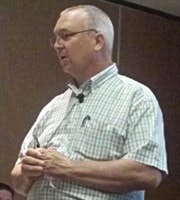The challenges for power plant owners to increase reliability and reduce cost have never been greater. As a result, many organizations are experimenting with numerous initiatives to meet these goals. Reliability-based maintenance (RBM) is a proactive approach to helping power plants achieve better results of delivering the highest availability and reliability at the lowest cost. Robert F. Ford, CMRP, RBM program manager at GE Power Generation Services in Atlanta described the journey he’s led at his organization, speaking at UE Systems’ Reliable Asset World conference in Clearwater Beach, Florida.
“I work for the O&M business under GE Power Generation Services where GE is contracted to run operations and maintenance for our customers at a facility” said Ford. “Back in the 1990s and early 2000s, the gas turbine market was going crazy. I worked for a mobilization team. We built the CMMS and supported site mobilization. The sites took it from there and after years of running the plant(s) everyone seemed to do it differently.”
We decided everyone did things differently, so I looked at several standards for electrical. Then I gathered together a team so we could develop a utility standard for our O&M business. We had to start somewhere. We standardized our power factor testing every three years and further developed our maintenance guidelines on the remaining critical assets to reduce variance and risk.
Once the fleet’s current status was benchmarked and a series of projects were designed to identify and quantify best practices, the results of each project were consolidated, memorialized and published into a document entitled “O&M Maintenance Playbook,” which outlines the requirements necessary for all existing and new facilities to achieve RBM. It includes reliability-based maintenance guidelines intended for consistent implementation across the operating fleet.
“Learning where to best utilize preventive and predictive maintenance helps diagnose problems before planned corrective work begins, thus avoiding unplanned repairs,” explained Ford.
GE Energy’s vision of RBM is to achieve for its customers optimum environmental, health and safety compliance, and desired plant operability, by establishing the most economical balance of corrective, preventive, and predictive maintenance activities to ensure plant assets perform as required.
Once the initiative was embraced throughout all levels of the organization, the next step was to determine which KPIs offered the best information to achieve the level of direction needed to make the best decisions and achieve the desired level of availability and reliability. The organization set a goal of expanding proactive maintenance and reducing corrective maintenance or unplanned work. The goals were 42% preventive maintenance, 42% predictive maintenance, and 16% corrective maintenance.
“Sometimes, we were over-maintaining nonessential assets,” he explained. “We had to shift the current strategy to spend less time working on nonessential assets and make sure we did the right maintenance on the most critical plant assets. So we had to reverse to current strategy.”
One of the first steps was to identify criticality of assets. “Our critical asset in a power plant is the turbine generator and certain critical support assets that can be single point failures which could trip the plant,” said Ford.
Then Ford established a five-stone pyramid to achieve RBM. The stones included management, data standardization, maintenance standardization, maintenance optimization, and RBM at the top.
“Experience has shown that a successful RBM program implementation has demonstrated that management engagement, coupled with data standardization and maintenance standardization, form the foundation on which organizations can build a solid program,” explained Ford.
Top management must adopt the vision and provide the leadership needed to successfully execute the RBM initiative, followed by good communication and training throughout all levels of the organization.
Standardization of data in the computerized maintenance management system (CMMS) is the first step toward gathering common elements for performance reporting. “To complete this, an initial site survey of the 25 plants was made to determine the amount of variation,” he said. “The study revealed significant variation in the CMMS configuration and data reporting. It was immediately evident that the CMMS was being utilized differently at each location, and standard reports were not available to measure maintenance performance.”
To learn the maintenance tasks completed across the fleet, a site survey of the 25 plants was completed to learn what we do from site to site. “We learned that we had variation and a common set of maintenance standards was needed to establish consistency, mitigate risk, improve plant operability and maximize site revenue streams,” said Ford. “To focus on the most critical plant assets, all 25 plants completed a failure modes and effects analysis (FMEA), a grading process that ranked equipment by process severity, repair time, probability of failure, ability to detect failure, and repair cost.”
The resulting scores were used to identify which critical assets would become the focus to develop and implement the organization’s maintenance standards. “The published guidelines are intended to ensure that all operating sites perform the right activities on the right equipment at the right intervals with some degree of variation allowed, based on experience and data,” he said. Site maintenance activities are subject to routine audits to validate compliance and exceptions.
“In the absence of standards you get poor quality,” explained Ford. “Our maintenance standardization efforts for our critical assets allowed us to be consistent across the fleet to better serve our customers and best protect their assets against premature failure.
His organization tracks KPIs such as work order aging and work order ratio reports. The group also captures short notice outage work (SNOW), which comprises work that can be done when the opportunity presents itself. “I love SNOW,” said Ford. “If we have a trip, and I’ve got an eight-hour window, I can go look in SNOW work orders and try to work them in instead of waiting for a major outage.” Any time you can move work out of your major outage we feel that we will improve safety.
Based on reporting over the past three years, Ford can determine that increased proactive maintenance means decreased corrective maintenance. And a decrease in proactive maintenance leads to an increase in corrective maintenance, which is more expensive. “This whole pitch is to drive proactive maintenance,” he explained. “Our proactive maintenance saves money. I’m pushing more predictive maintenance. The more proactive maintenance we do the more money we save."


